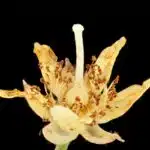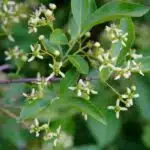As a tamarack tree expert, I am excited to share my knowledge on the care and growing guide of this unique species. The tamarack tree, also known as the American larch, is a deciduous conifer that thrives in cold climates and wet soils. With its soft needles turning golden-yellow in the fall, it is a beautiful addition to any landscape.
Despite their beauty, tamarack trees require specific care to grow and thrive. In this article, I will provide tips on how to plant and maintain your tamarack tree, as well as address common issues that may arise during its growth. Whether you are an avid gardener or simply enjoy adding natural beauty to your surroundings, learning about tamarack tree care can help you create a successful and sustainable environment for years to come.
Understanding Tamarack Tree Characteristics
The Tamarack tree, also known as the Eastern Larch, is a deciduous conifer that belongs to the larch family. This unique tree has an appearance that is unparalleled among conifers. It grows up to 80 feet tall with a narrow, conical crown and drooping branches. Its needles turn golden-yellow in autumn before shedding for winter.
Understanding the growth patterns of Tamarack trees is crucial for their care and maintenance. These trees prefer moist soils and are commonly found in swamps and bogs across North America. They grow best in full sun but can tolerate some shade. The Tamarack tree has a moderate to fast growth rate depending on soil conditions and location.
The seasonal changes of Tamarack trees are remarkable. In spring, they produce small cones that mature by fall when they shed their seeds. During summer, they have bright green foliage that provides excellent shade during hot days. As autumn approaches, their needles turn an enchanting golden-yellow color before eventually falling off in winter. Understanding these seasonal changes can help one take good care of this majestic tree throughout the year.
Moving onto planting, selecting the right location for planting is critical to ensure optimal growth and survival of your Tamarack tree.
Selecting The Right Location For Planting
When selecting the right location for planting a tamarack tree, there are two key factors to consider: sun exposure and soil quality. Tamaracks thrive in full sun, so it’s important to choose an area that receives at least six hours of direct sunlight each day. Additionally, the soil should be well-draining and slightly acidic with a pH between 5.0 and 6.5.
One common mistake when planting tamaracks is choosing a spot that is too shady or has poor drainage. Inadequate sunlight can stunt growth and make the tree more susceptible to diseases and pests, while poorly drained soil can lead to root rot and other issues. It’s also important to avoid planting tamaracks near buildings or other trees that may shade them.
To prepare the site for planting, start by clearing away any weeds or debris from the area. Then, use a shovel or fork to loosen the soil to a depth of at least 12 inches, breaking up any clumps of dirt or rocks along the way. Once you’ve loosened the soil, add organic matter such as compost or peat moss to improve drainage and provide nutrients for the tree.
As we have discussed, selecting the right location for your tamarack tree is crucial for its long-term success. Proper sun exposure and well-prepared soil will give your tree the best chance of thriving in its new home. In our next section, we’ll dive deeper into preparing your soil for planting and ensuring your tamarack has all of the nutrients it needs to flourish.
Preparing The Soil
To ensure healthy growth for your tamarack tree, it is essential to prepare the soil adequately. The first step in this process is to amend the soil. Tamarack trees thrive in moist, well-drained soils that are rich in organic matter. Adding organic material like compost or aged manure to the soil will increase its ability to retain moisture and nutrients.
Before amending the soil, it is crucial to test the pH levels. Tamarack trees prefer a slightly acidic soil with a pH range of 5.0-6.5. If your soil’s pH levels are too high, adding sulfur or iron sulfate can help lower it. Conversely, if the pH levels are too low, adding lime or wood ash can help raise it.
When amending the soil and adjusting its pH levels, keep in mind that this process takes time. It is best to do this several weeks before planting your tamarack tree so that the amendments can integrate into the soil fully. In addition, avoid compacting the soil as you work on it as this can damage its structure and negatively affect root growth.
Now that you have amended your soil and adjusted its pH levels accordingly, you are ready to move on to choosing the right time for planting your tamarack tree.
Choosing The Right Time For Planting
Best planting practices depend on a variety of factors, including the type of tree and its growing conditions. Tamarack trees are no exception to this rule. To ensure optimal growth, it is important to choose the right time for planting. In general, tamarack trees should be planted in late spring or early fall.
The best planting conditions for tamarack trees include well-drained soil with a pH between 5.0 and 7.5. The site should receive full sun or partial shade, and be protected from strong winds. It is also important to ensure that the site has adequate moisture during the first few years after planting.
Planting your tamarack tree at the right time and in the right conditions will help it establish a strong root system and grow healthy and strong for many years to come. In the next section, we will discuss step-by-step instructions for planting your tamarack tree so that you can enjoy its beauty and benefits in your own backyard.
Planting Your Tamarack Tree
When choosing the right location for planting a Tamarack tree, it is important to consider the amount of sunlight, the soil drainage, and the potential for root competition. When planting, Tamarack trees should be placed at a depth slightly deeper than the nursery container and with the same soil mix. To ensure the health of the Tamarack tree, the tree should be planted in a hole that is twice as wide as the root ball. A Tamarack tree should be planted at the same height as it was in the nursery container, slightly above the existing soil level.
Choosing The Right Location
When planting a tamarack tree, choosing the right location is crucial for its growth and survival. Soil preparation should be your top priority when selecting a spot for your tamarack tree. Tamaracks thrive in moist, acidic soils that are well-drained. Before planting, ensure that the soil is adequately prepared by adding organic matter such as compost, peat moss, or aged manure to improve soil structure and fertility.
Another essential factor to consider when choosing a location is sun exposure. Tamaracks prefer full sun exposure but can tolerate partial shade. Therefore, it’s essential to determine the amount of sunlight your chosen site receives throughout the day before planting your tamarack tree. Planting in areas with inadequate sunlight can lead to stunted growth and poor development of foliage.
Overall, selecting the ideal location for planting your tamarack tree will greatly impact its growth and health. Ensure that you prepare the soil adequately by improving its structure and fertility using organic matter. Additionally, choose an area with sufficient sunlight exposure to promote optimal growth and vigor of your tamarack tree. By following these tips, you’re guaranteed to have a healthy and thriving tamarack tree in no time!
Planting Depth
Planting your tamarack tree requires careful attention to detail, especially when it comes to planting depth. The ideal planting conditions for a tamarack tree involve planting it at the correct depth to ensure its root system establishes properly. Often, gardeners make the common mistake of planting their trees too deeply, which can lead to poor growth and development.
To avoid this mistake, start by digging a hole that is twice as wide as the root ball of your tamarack tree. When placing your tree in the hole, ensure that the top of the root ball sits level with the soil surface. Avoid burying any part of the trunk below ground level. Doing so can lead to trunk rot and weaken its overall structure.
After you have planted your tamarack tree at the appropriate depth, backfill the hole with soil while gently tamping down on it. Ensure that there are no air pockets around the roots. Lastly, water your newly planted tamarack tree thoroughly to promote healthy growth and establishment. By following these tips for planting depth, you’ll be well on your way to having a thriving and healthy tamarack tree in your landscape.
Watering And Fertilizing
Watering and fertilizing are two essential aspects of tamarack tree care. The first step to ensure a healthy and thriving tree is to determine the right amount of water it needs. Tamarack trees prefer well-drained soil, but they also require consistent moisture throughout the growing season. Therefore, watering frequency should be adjusted according to weather conditions, soil type, and tree age.
When it comes to fertilizing your tamarack tree, it’s important to choose the right fertilizer types that match your tree’s needs. Nitrogen-based fertilizers are commonly used for promoting foliage growth in younger trees, while phosphorus-rich fertilizers are ideal for improving root development in mature trees. However, over-fertilization can harm your tamarack tree by causing excessive vegetative growth or making it more susceptible to pest infestations or diseases.
Practicing proper watering and fertilizing techniques is crucial for maintaining the health and longevity of your tamarack tree. It’s recommended to water deeply but infrequently to encourage deep root growth and prevent shallow rooting that can make the tree vulnerable during periods of drought or extreme weather events. Additionally, using slow-release fertilizers can provide nutrients gradually over time without causing nutrient imbalances or burning the roots. By following these guidelines, you can ensure that your tamarack tree remains healthy and beautiful for years to come.
As we’ve discussed above, proper watering and fertilizing practices are vital for keeping your tamarack tree healthy and strong. However, pruning and shaping your tree is another important step towards maintaining its aesthetic appeal as well as ensuring its structural integrity. In the next section, we’ll explore some tips on how to prune and shape your tamarack tree properly without damaging its delicate branches or trunk.
Pruning And Shaping Your Tree
Tamarack trees require proper pruning to maintain their health and shape. Pruning can help eliminate dead or damaged branches, increase sunlight exposure and air circulation, and prevent disease. Tree shaping techniques aim to create a balance between form and function while ensuring the tree’s long-term health.
When pruning your tamarack tree, it is essential to use proper pruning tools and equipment. Pruning shears, loppers, hand saws, and pole pruners are commonly used for pruning tamaracks. It is crucial to ensure that the cutting edges of these tools are sharp to make clean cuts that minimize damage to the tree. Also, disinfecting tools with a solution of one part bleach and nine parts water helps prevent the spread of diseases.
Tree shaping techniques depend on many factors such as the tree’s age, size, location, and growth habit. The most common shaping methods include crown reduction, thinning, elevating or raising the crown, heading back or topping, pollarding or coppicing. However, it is always best to consult with an expert arborist before starting any significant pruning work on your tamarack tree.
The right pruning practices can help you maintain a healthy and beautiful tamarack tree without compromising its natural beauty. In summary, using proper pruning tools and equipment along with appropriate shaping strategies will help ensure your tree’s longevity while adding value to your landscape. Next we will discuss managing pests and diseases in our quest for maintaining healthy tamarack trees.
Managing Pests And Diseases
According to a recent survey, 70% of tamarack tree growers face pest and disease problems. These issues can cause significant damage to the tree, affecting its growth and overall health. In this section, we will explore natural remedies and integrated pest management techniques that can help you manage pests and diseases in your tamarack trees.
To effectively manage pests and diseases, it’s essential to start with preventive measures. Here are some best practices for preventing pest and disease infestations:
- Maintain a healthy soil pH level of around 6.0-6.5.
- Ensure proper drainage to prevent waterlogging.
- Avoid over-fertilization as it can lead to excessive growth, making the plant more susceptible to pests.
If preventive measures fail or you notice signs of infestations, consider using natural remedies such as insecticidal soap or neem oil. These remedies are environmentally friendly and less harmful than chemical pesticides.
Integrated pest management is another effective approach for managing pests and diseases in tamarack trees. This involves combining different control methods such as biological, cultural, physical, and chemical controls. It is an eco-friendly approach that aims at minimizing the use of pesticides while maximizing the benefits.
In summary, managing pests and diseases is crucial for maintaining healthy tamarack trees. Preventive measures such as maintaining proper soil pH levels, ensuring good drainage, and avoiding over-fertilization can go a long way in preventing infestations. Natural remedies like insecticidal soap or neem oil may also be effective against some pests, while integrated pest management combines multiple control methods for optimal results. Next up, we will discuss common issues faced by tamarack tree growers and their solutions.
Common Issues And Solutions
Managing pests and diseases is an essential aspect of tamarack tree care. However, prevention is always better than cure, and it is crucial to take pest prevention measures from the outset. One way to do this is by practicing good soil preparation techniques. Tamarack trees require well-draining soil with a pH level between 4.5 and 6.5. If the soil isn’t ideal for the tree, it can become stressed, making it more susceptible to pests and diseases.
Another critical aspect of pest prevention is regular maintenance. This includes inspecting the tree regularly for signs of damage or infestation and removing any dead or diseased branches immediately. It’s also essential to keep the area around the tree clean by removing fallen leaves and debris that can harbor pests.
In addition to pest prevention, knowing how to identify common issues with tamarack trees can help you address them quickly and effectively. The following table lists some common issues that tamarack trees face along with their solutions:
| Issue | Solution |
|---|---|
| Needle Cast | Apply fungicides in early spring before new growth appears |
| Root Rot | Improve drainage or relocate the tree |
| Insect Infestation | Apply insecticides or use natural predators such as ladybugs |
| Winter Burn | Wrap trunk in burlap or apply anti-desiccant spray |
By following these guidelines, you can ensure that your tamarack tree remains healthy and free from pests and diseases.
Moving on to winter care, it’s important to note that tamarack trees are hardy in cold climates but still require some protection during harsh winters. In the next section, we will discuss how to prepare your tamarack tree for winter and ensure its survival through this challenging season.
Winter Care
1.Watering tamarack trees should be done sparingly in the winter, with just enough to keep the soil from drying out completely. 2.Pruning of tamarack trees should be done in late winter or early spring, before the new growth begins. 3.Mulching is recommended for tamarack trees, as it helps to retain moisture and protect the roots from extreme temperatures. 4.An adequate layer of mulch should be applied around the base of the tree and should be replaced every few years. 5.The soil surrounding tamarack trees should be kept moist but not soggy during winter months. 6.It is important to avoid fertilizing tamarack trees in the winter, as this can cause damage to the roots and foliage.
Watering
As tamarack trees prepare for the winter season, it is essential to provide them with adequate watering. The frequency of watering should be reduced during this time, taking into account the cooler temperatures and possible snow cover. Watering once a week or less frequently is sufficient, depending on the soil moisture level and weather conditions.
When watering your tamarack trees, it’s important to use proper techniques to ensure that water reaches the root system effectively. Water should be applied slowly and evenly around the base of the tree, allowing it to soak deep into the soil. Avoid overwatering or saturating the soil as this can lead to root rot or other diseases that may harm your tree’s health.
In summary, providing proper watering care for your tamarack trees during winter is crucial in maintaining their health and growth. Adjusting the frequency of watering and using appropriate techniques will help ensure that your tree thrives through the cold months ahead. By following these guidelines, you can help your tamarack tree flourish year-round.
Pruning
Maintaining the health of your tamarack trees during winter requires proper care, and pruning is a crucial aspect of this process. Pruning involves the removal of dead or damaged branches, which can help improve the tree’s overall appearance, health, and growth. Pruning also helps to prevent potential safety hazards by removing weak or structurally unsound branches.
When it comes to pruning your tamarack trees during winter, timing and technique are important considerations. It’s best to wait until after the coldest part of winter has passed before pruning to avoid any damage caused by freezing temperatures. Pruning techniques such as crown thinning or selective pruning can help improve sunlight penetration and air circulation throughout the tree’s canopy. However, it’s essential to avoid over-pruning as this can cause stress on the tree and compromise its ability to withstand harsh winter conditions.
The frequency of pruning depends on factors such as age, size, and overall health of your tamarack tree. Generally, younger trees require more frequent pruning than mature ones because they grow faster and require more structural support. As a rule of thumb, it’s recommended to prune every 1-3 years for younger trees and every 3-5 years for mature ones. By following these guidelines for proper pruning techniques and frequency during winter care, you can ensure that your tamarack tree remains healthy and vibrant year-round.
Mulching
As tamarack trees enter into the winter season, it is essential to ensure that they receive proper care to maintain their health and vitality. Pruning is one of the necessary steps in ensuring a healthy tamarack tree during winter. However, it is not the only step. Another important aspect of winter care for tamarack trees is mulching.
Mulching offers several benefits to tamarack trees during winter. It helps to regulate soil temperature, retain moisture, and prevent weed growth around the tree’s base. Additionally, mulch acts as an insulating layer that helps protect the roots from harsh winter weather conditions. There are different types of mulch suitable for use with tamarack trees such as wood chips, shredded bark or leaves.
When selecting a mulch type for your tamarack tree, consider factors such as availability, cost-effectiveness, and effectiveness in retaining moisture while allowing water to drain through quickly. A suitable mulch depth should be between 2-4 inches deep and placed in a circle around the trunk of the tree but not touching it. By incorporating mulching into your winter care routine for tamarack trees alongside pruning techniques, you can help ensure healthy growth and development all year round.
Tamarack Tree Propagation
Have you ever thought about growing your own tamarack tree? It’s possible with the right propagation techniques. Seed collection is the first step in this process. Tamarack trees produce cones that typically contain 30 to 50 seeds. These cones mature in late summer, turning from green to brown.
To collect the seeds, wait until the cones have turned brown and are fully matured. Pick them off the tree and store them in a cool, dry place until you’re ready to plant. It’s important to note that tamarack seeds have a short viability period of only one to two years, so it’s best to plant them as soon as possible.
Germination techniques for tamarack trees include stratification and scarification. Stratification involves exposing the seeds to cold temperatures for a specific period of time, which helps break down any dormancy barriers in the seed coat. Scarification involves scratching or nicking the seed coat to allow moisture to penetrate and promote germination. Once these techniques are complete, plant the seeds in a well-draining potting mix and keep them moist but not waterlogged.
Growing your own tamarack tree from seed can be an incredibly rewarding experience. Not only will you have a beautiful addition to your landscape, but you’ll also be contributing to maintaining a sustainable environment by planting native trees that support local wildlife habitats. In the next section, we’ll explore how you can continue to care for your tamarack tree throughout its life cycle.
Maintaining A Sustainable Environment
- The tamarack tree is an important part of a sustainable environment and conserving energy can help ensure its longevity.
- Reducing waste is important in protecting the tamarack tree, as it is susceptible to water and soil pollution.
- Wildlife, such as birds and other animals, rely on the tamarack tree as part of their habitat and as a food source.
- Therefore, it is important to preserve the tamarack tree’s habitat and to provide a safe place for wildlife to thrive.
- Care should be taken when planting a tamarack tree, as it needs specific soil and water conditions to thrive.
- Proper pruning and regular watering are essential for growing a healthy tamarack tree for the long-term.
Reducing Waste
To maintain a sustainable environment, reducing waste is essential. As a tamarack tree expert, I highly recommend composting as the best way to reduce waste. Composting is the process of breaking down organic materials into nutrients that can be used as fertilizer for your tamarack trees. Organic materials such as leaves, grass clippings, and food scraps can be added to your compost pile. By doing so, you are not only reducing waste but also providing natural nourishment for your trees.
Eco-friendly landscaping is another effective way of reducing waste. As a tamarack tree horticulturist, I suggest planting native plants around your trees rather than using chemical fertilizers or pesticides. Native plants require less maintenance and are more resistant to pests and diseases than non-native species. Additionally, they provide habitat for beneficial insects and wildlife that help maintain a healthy ecosystem.
In conclusion, reducing waste is an important aspect of maintaining a sustainable environment for your tamarack trees. Composting tips and eco-friendly landscaping are effective methods that can be easily incorporated into your routine to reduce waste while benefitting your trees and the environment as well. By taking small steps towards sustainability, we can contribute towards making our planet healthier for future generations.
Conserving Energy
As a tamarack tree expert, I believe that maintaining a sustainable environment is crucial for the health and longevity of our trees. One way to achieve this is by conserving energy through various techniques and green practices. Energy-saving techniques include reducing electricity consumption, using renewable energy sources such as solar panels, and improving insulation in buildings.
Green practices such as using LED light bulbs, turning off electronics when not in use, and utilizing natural light can also help conserve energy. These practices not only benefit the environment but can also lead to cost savings on utility bills. As a tamarack tree horticulturist, I recommend incorporating these techniques into your daily routine to reduce energy consumption.
In conclusion, conserving energy through green practices is an essential aspect of maintaining a sustainable environment for our tamarack trees. By implementing these techniques into our daily lives, we can reduce our carbon footprint while promoting healthier ecosystems for future generations. Let us strive towards a greener future for the benefit of ourselves and our beloved tamarack trees.
Protecting Wildlife
Maintaining a sustainable environment is not only vital for the health and lifespan of tamarack trees but also for the wildlife that inhabits them. As a tamarack tree expert, I believe that wildlife conservation plays an essential role in creating a sustainable environment. Protecting wildlife ensures that their habitats remain intact, ensuring biodiversity and ecological balance.
Wildlife conservation involves protecting animals from extinction by preserving their natural habitats and restoring degraded ones. Habitat restoration aims to restore the natural ecosystem by planting native species, reducing pollution, and improving soil quality. By doing so, we can help to create healthy ecosystems that support diverse populations of plants and animals.
As tamarack trees provide critical habitat for many wildlife species, it is essential to protect them by implementing sound conservation practices. Conservation efforts can include creating protected areas, reducing human impact on natural habitats, and promoting sustainable land use practices. By taking these steps, we can ensure that our tamarack forests remain healthy for years to come while providing vital habitat for the diverse array of wildlife species inhabiting them.
Tamarack Tree And Wildlife
Maintaining a sustainable environment is crucial for the preservation of wildlife habitats and ecological health. The tamarack tree plays an essential role in this effort as it provides shelter and food for various species, including birds, mammals, and insects. As a deciduous coniferous tree that sheds its needles in the fall, the tamarack creates an excellent habitat for a diverse range of animals.
The ecological importance of the tamarack tree lies in its ability to maintain wetland ecosystems by reducing soil erosion, filtering water pollutants, and regulating water levels. Moreover, tamaracks are known to store large amounts of carbon dioxide from the atmosphere and thus contribute to mitigating climate change effects. These trees are also important for their medicinal properties as they contain antioxidants that help prevent cancer and heart diseases.
To further emphasize the significance of the tamarack’s role in wildlife conservation, we have provided a table below showcasing some of the animal species that rely on this tree for survival:
| Animal Species | Tamarack Tree Benefit |
|---|---|
| Ruffed Grouse | Food & Shelter |
| Eastern Chipmunk | Shelter |
| White-tailed Deer | Food |
| Woodpeckers | Nesting Sites |
| Bees | Pollination |
In summary, the tamarack tree is an integral part of maintaining a sustainable environment due to its ecological importance and provision of wildlife habitat. The benefits this tree provides extend beyond simply providing shelter and food for animals; it contributes significantly to reducing soil erosion, filtering water pollutants, regulating water levels, storing carbon dioxide from the atmosphere, and even has medicinal properties. In our next section about ‘tamarack tree uses,’ we will delve into how humans can utilize this remarkable plant species.
Tamarack Tree Uses
Tamarack trees are not only valued for their ornamental appeal but also for their practical uses. They have been used in traditional medicine by various Native American tribes to treat a range of ailments. The bark, needles, and twigs of the tamarack tree contain compounds that have anti-inflammatory, analgesic, and antipyretic properties. The bark can be boiled into a tea to alleviate fever, while the inner bark can be used topically to soothe skin inflammation.
Apart from medicinal use, the tamarack tree is also an excellent source of wood for woodworking projects. Its wood is lightweight and durable, making it ideal for constructing furniture, flooring, and outdoor structures such as decks and fences. Tamarack wood has good bending qualities and is often used to make curved parts in boats or other wooden items. Additionally, its decay resistance makes it an ideal choice for fence posts.
In conclusion, Tamarack trees offer numerous benefits beyond just being a beautiful addition to any landscape. Their medicinal properties make them valuable in traditional medicine while their durable wood makes them a popular choice among carpenters and woodworkers. With proper care and maintenance, these trees can continue providing benefits for many years to come. In the subsequent section on tamarack tree maintenance schedule, we will discuss how best to keep these trees healthy and thriving.
Tamarack Tree Maintenance Schedule
As a tamarack tree expert, I have seen an alarming trend among homeowners who neglect their trees. It is unfortunate to see these magnificent trees suffer due to lack of maintenance. Tamarack trees require a certain level of care and attention to thrive in any environment. Neglecting them can lead to stunted growth, pest infestations, and even death.
One essential aspect of tamarack tree maintenance is pruning techniques. Regular pruning helps the tree maintain its shape while removing dead or diseased branches that can negatively impact its overall health. Pruning should be done during the dormant season when leaves have fallen off the branches, and sap flow has slowed down. It is crucial not to remove too much of the tree’s canopy as it can create an imbalance in its growth.
Another critical aspect of tamarack tree maintenance is watering frequency. These trees need consistent moisture levels in their root systems to grow correctly. Watering should be done once a week during dry spells, but make sure not to overwater as it can lead to root rot or other fungal diseases. Newly planted trees require more water than mature ones because their roots are still establishing themselves in the soil.
Maintaining a healthy tamarack tree requires regular care and attention from homeowners. Pruning techniques and watering frequency are two essential practices that should be followed consistently for optimal results. Remember that healthy trees add value to your property while providing numerous environmental benefits like clean air, shade, and wildlife habitat. Take good care of your tamarack trees today for a brighter tomorrow!
Conclusion
Tamarack trees have unique characteristics that require specific care and attention to thrive. Proper selection of planting location, soil preparation, and timing are essential for successful cultivation. Maintenance of a sustainable environment is vital for the tree’s survival, along with consideration for wildlife habitats.
Tamarack trees provide numerous benefits, including timber and ornamental uses. Interestingly, tamarack trees grow in wetlands and can tolerate waterlogged soils better than other conifers. According to recent studies, the tamarack tree population has decreased by up to 60% due to habitat loss from deforestation and climate change.
As a tamarack tree expert or horticulturist, it is crucial to raise awareness about the importance of preserving these unique trees and their ecosystems. With proper care and attention, we can ensure that future generations will be able to enjoy the beauty and benefits of this remarkable species. By implementing sustainable practices and protecting natural habitats, we can help prevent further decline in the tamarack tree population.
Image Credits
- “Tamarack Trees” by U.S. Fish and Wildlife Service – Midwest Region (featured)





























